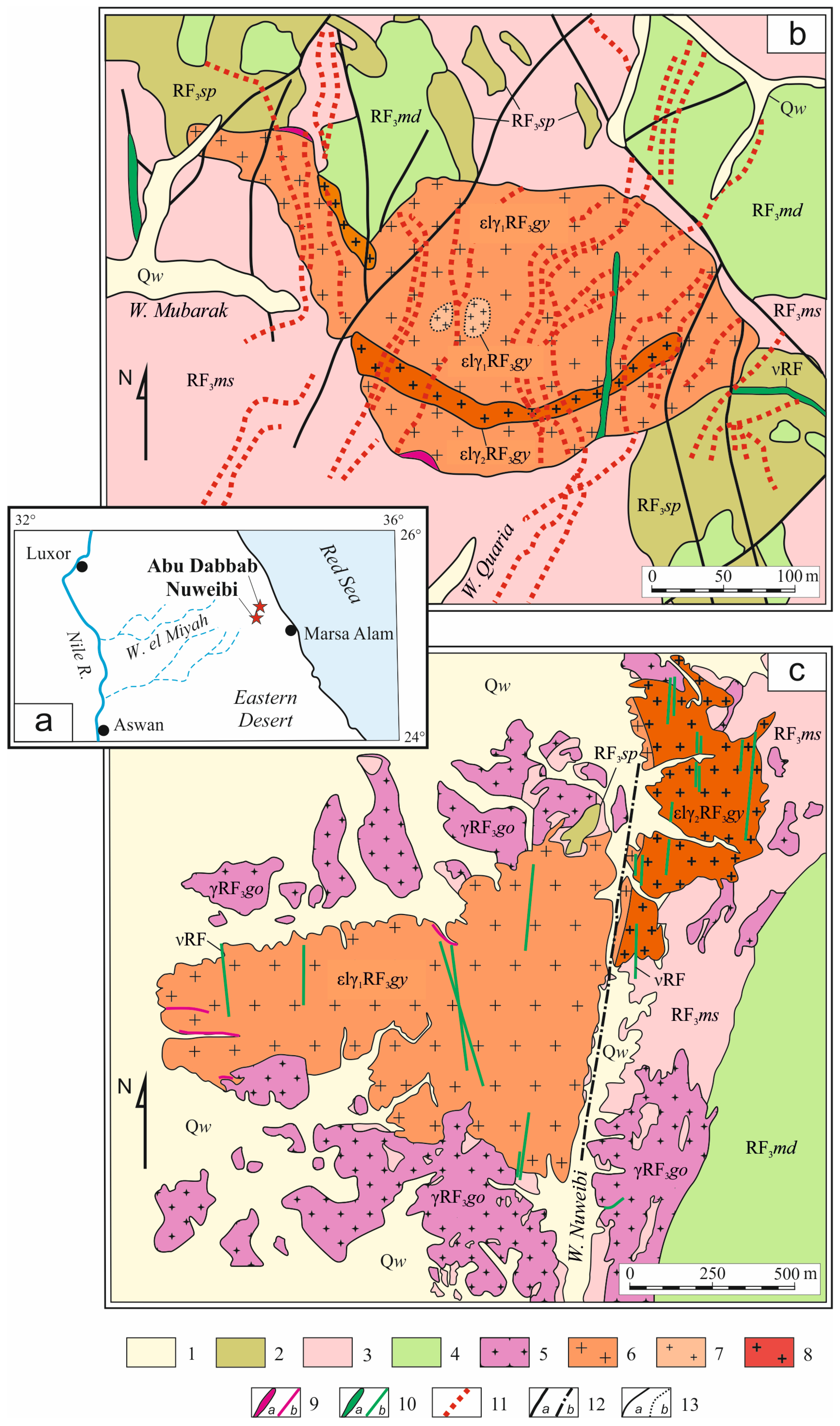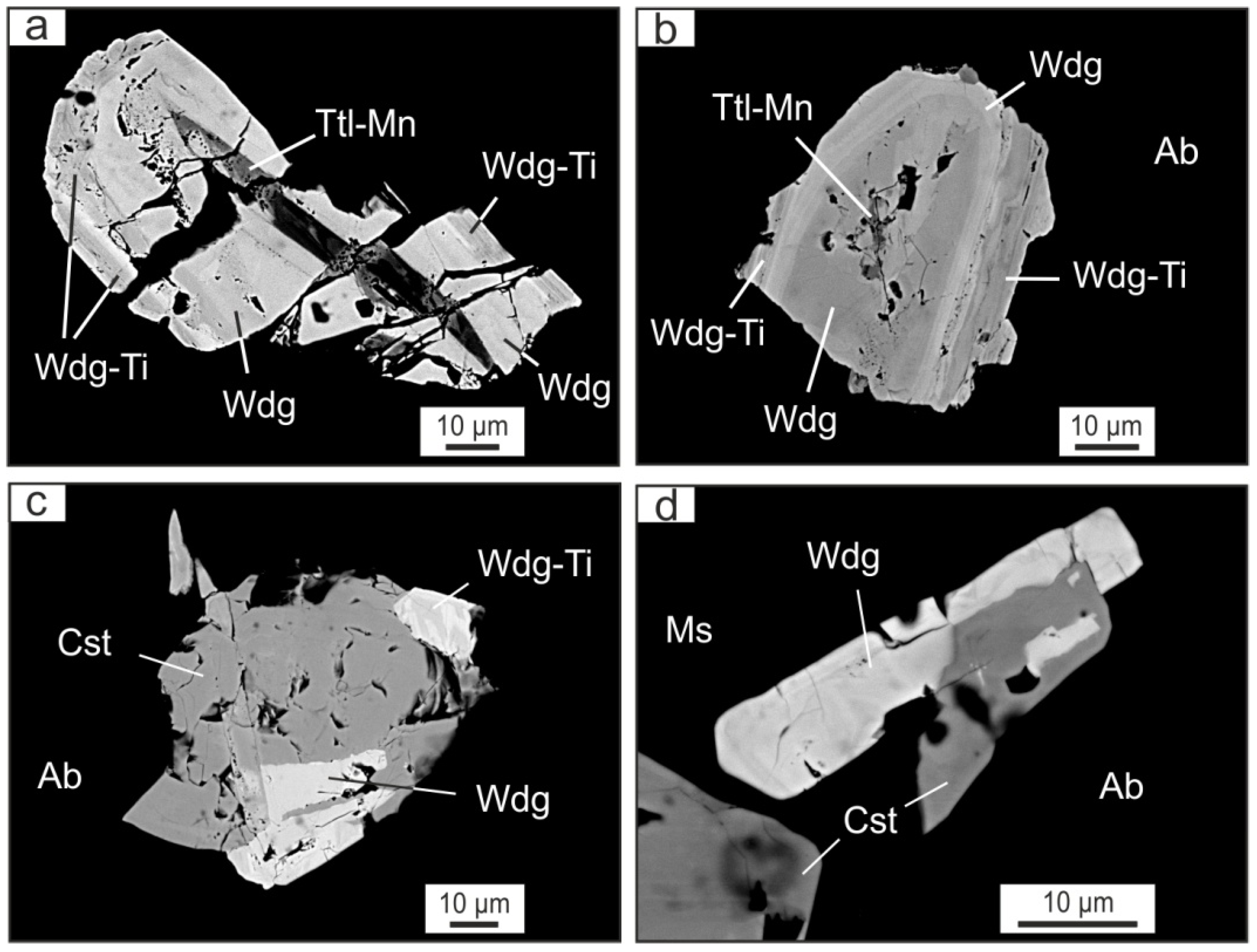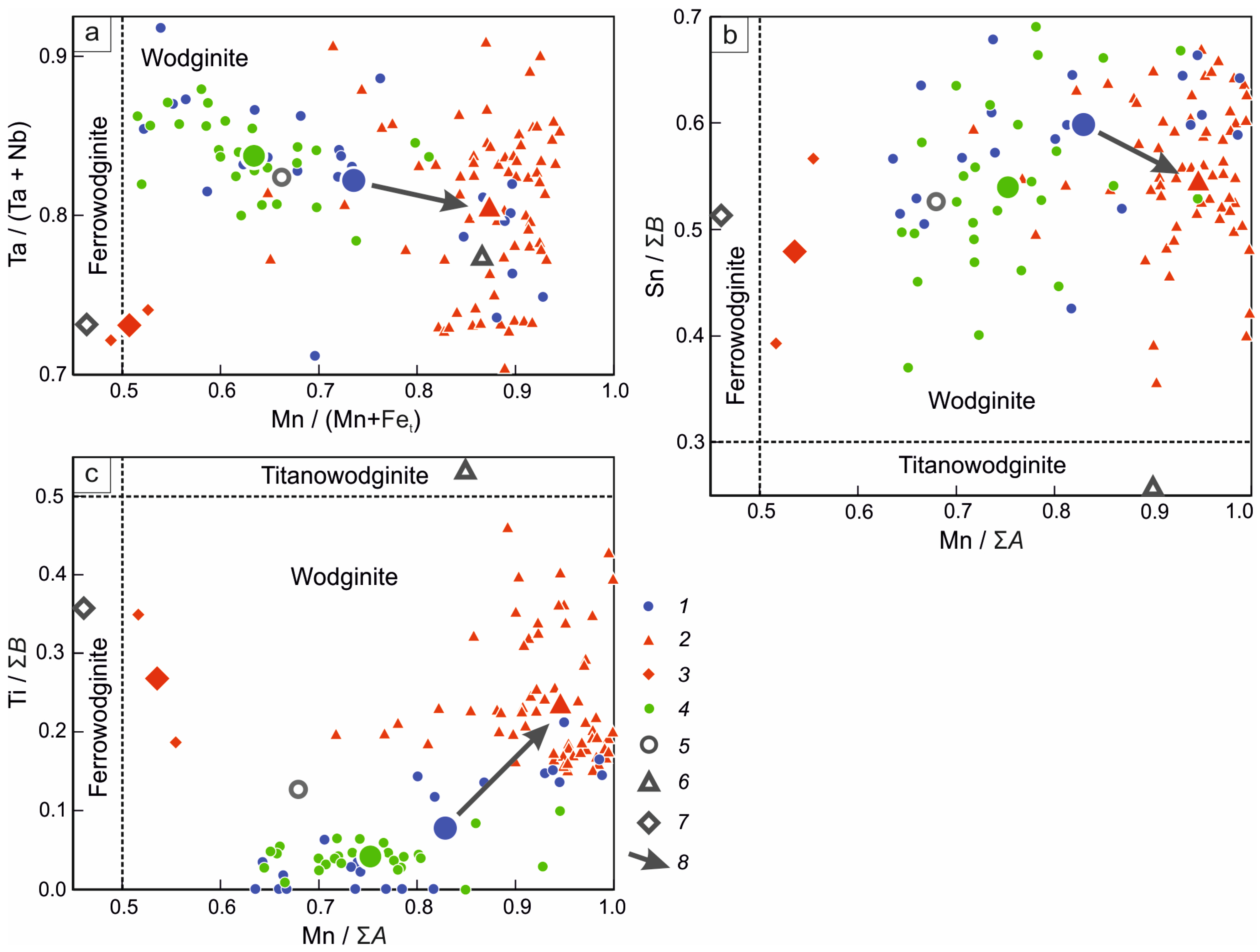The Presence of Wodginite in Lithium–Fluorine Granites as an Indicator of Tantalum and Tin Mineralization: A Study of Abu Dabbab and Nuweibi Massifs (Egypt)
Abstract
:1. Introduction
2. Materials and Methods
- Leica DM 2500 M (Leica Microsystems, Wetzlar, Germany) microscope for petrographic analysis;
- XRF-1800 (Shimadzu Corporation, Kyoto, Japan) X-ray fluorescence spectrometry for major and trace elements;
- ICPE-9000 (Shimadzu Corporation, Kyoto, Japan) inductively coupled plasma mass spectrometry for rare earth elements (REE) and yttrium (Y).
- JEOL JSM-6510LA (JEOL Ltd., Tokyo, Japan) scanning electron microscope with the JED-2200 energy-dispersive spectrometer;
- Accelerating voltage 20 kV, current 1.5 nA;
- ZAF correction method for matrix effects.
3. Geological Setting
3.1. Regional Geology
3.2. Geological Characteristics of the Abu Dabbab Massif
3.3. Geological Characteristics of the Nuweibi Massif
4. Results
4.1. Morphology and Size of Accessory Wodginite in the Abu Dabbab and Nuweibi Massifs
4.2. Composition of Wodginite from the Abu Dabbab and Nuweibi Deposits
5. Discussion
5.1. Genesis of Wodginite
5.2. Isomorphism and Genetic Significance of Titanium-Bearing Wodginite
6. Conclusions
- Accessory minerals of the wodginite group, wodginite, Ti-bearing wodginite, and rare Fe and Ti-bearing wodginite associated with Ta-bearing cassiterite and Sn-bearing tantalum-niobates, are distributed in the lithium–fluorine granites of the Eastern Desert of Egypt.
- Three forms of wodginite crystallization are identified: (1) rims in columbite–tantalite; (2) micro-inclusions in cassiterite; (3) autonomous crystals. The average size of wodginite crystals is 34.6 µm. Wodginite crystals represent partial or complete pseudomorphs after tantalite-(Mn). Wodginite is marker of the transition from late-magmatic crystallization of rare-metal granitic magma to pneumatolitic mineral formation in the presence of a fluid phase.
- Wodginite of the Nuweibi massif mainly occurs in the porphyritic granites of an additional granitic phase. It is close in composition to the worldwide wodginite of rare-metal granites, is distinguished by a reduced TiO2 content, and is a mineral indicator of rich tantalum mineralization.
- Wodginite in the Abu Dabbab massif is replaced by Ti-bearing wodginite, and both types are maximally enriched with Mn. They are represented in all intrusive phases of the massif, and are very likely to be mineral indicators of tantalum-bearing granites with accompanying cassiterite–quartz mineralization.
Author Contributions
Funding
Data Availability Statement
Acknowledgments
Conflicts of Interest
References
- Küster, D. Granitoid-hosted Ta mineralization in the Arabian–Nubian Shield: Ore deposit types, tectono-metallogenetic setting and petrogenetic framework. Ore Geol. Rev. 2009, 35, 68–86. [Google Scholar] [CrossRef]
- Nikishina, E.E.; Drobot, D.V. Niobium and tantalum: Global market status, application areas, raw material sources. Part 2. Izvest. Vuzov. Tsvetnaya Metall. 2014, 1, 29–41. (In Russian) [Google Scholar]
- Zhu, Z.Y.; Wang, R.C.; Che, X.D.; Zhu, J.C.; Wei, X.L.; Huang, X. Magmatic–hydrothermal rare-element mineralization in the Songshugang granite (northeastern Jiangxi, China): Insights from an electron-microprobe study of Nb–Ta–Zr minerals. Ore Geol. Rev. 2015, 65, 749–760. [Google Scholar] [CrossRef]
- Simandl, G.J.; Burt, R.O.; Trueman, D.L.; Paradis, S. Economic geology models 4. Tantalum and niobium: Deposits, resources, exploration methods and market—A primer for geoscientists. Geosci. Can. 2018, 45, 85–96. [Google Scholar] [CrossRef]
- Rub, A.K.; Rub, M.G. Rare-Metal Granites of Primorye; VIMS: Moscow, Russia, 2006; 86p. (In Russian) [Google Scholar]
- Mackay, D.A.R.; Simandl, G.J. Geology, market and supply chain of niobium and tantalum—A review. Miner. Depos. 2014, 49, 1025–1047. [Google Scholar] [CrossRef]
- Beskin, S.M.; Marin, Y.B. Granite Systems with Rare-Metal Pegmatites. Geol. Ore Depos. 2020, 62, 554–563. [Google Scholar] [CrossRef]
- Van Lichtervelde, M.; Salvi, S.; Beziat, D.; Linnen, R.L. Textural features and chemical evolution in tantalum oxides: Magmatic versus hydrothermal origins for Ta mineralization in the Tanco Lower pegmatite, Manitoba, Canada. Econ. Geol. 2007, 102, 257–276. [Google Scholar] [CrossRef]
- Huang, X.L.; Wang, R.C.; Chen, X.M.; Hu, H.; Liu, C.S. Vertical variations in the mineralogy of the Yichun topaz-lepidolite granite, Jiangxi Province, southern China. Can. Mineral. 2002, 40, 1047–1068. [Google Scholar] [CrossRef]
- Wu, M.; Samson, I.M.; Zhang, D. Textural and Chemical Constraints on the Formation of Disseminated Granite-hosted W-Ta-Nb Mineralization at the Dajishan Deposit, Nanling Range, Southeastern China. Econ. Geol. 2017, 112, 855–887. [Google Scholar] [CrossRef]
- Tian, E.; Wang, R.; Xie, L.; Che, X.; Zhang, R. Mineralogy and geochemistry of the newly discovered Late Mesozoic granite-pegmatite and associated Sn-Nb-Ta-Be mineralization in the Miao’ershan-Yuechengling composite batholith, northern Guangxi, South China. J. Asian Earth Sci. 2020, 190, 104149. [Google Scholar] [CrossRef]
- Moussa, H.E.; Asimow, P.D.; Azer, M.K.; Maaty, M.A.; Akarish, A.I.M.; Yanni, N.N.; Mubarak, H.S.; Wilner, M.J.; Elsagheer, M.A. Magmatic and hydrothermal evolution of highly-fractionated rare-metal granites at Gabal Nuweibi, Eastern Desert, Egypt. Lithos 2021, 400, 106405. [Google Scholar] [CrossRef]
- Kesraoui, M.; Nedjari, S. Contrasting evolution of low-P rare metal granites from two different terranes in the Hoggar area, Algeria. J. Afr. Earth Sci. 2002, 34, 247–257. [Google Scholar] [CrossRef]
- Alekseev, V.I. Wodginite as an indicator mineral of tantalum-bearing pegmatites and granites. J. Min. Inst. 2023, 262, 495–508. [Google Scholar] [CrossRef]
- Beskin, S.M.; Marin, Y.B. Comprehensive systematics of tantalum and tantalum-niobium deposits. Proc. Russ. Mineral. Soc. 2015, 144, 45–54. (In Russian) [Google Scholar] [CrossRef]
- Ercit, T.S.; Černý, P.; Hawthorne, F.C. The wodginite group. III. Classification and new species. Can. Mineral. 1992, 30, 633–638. [Google Scholar]
- Ercit, T.S.; Černý, P.; Hawthorne, F.C.; McCammon, C.A. The wodginite group. II. Crystal chemistry. Can. Mineral. 1992, 30, 613–631. [Google Scholar]
- Krivovichev, V.G.; Gulbin, Y.L. Recommendations for calculating and presenting mineral formulas based on chemical analysis. J. Min. Inst. 2022, 151, 114–124. [Google Scholar]
- Vasilev, E.A.; Kriulina, G.Y.; Garanin, V.K. Thermal history of diamond from Arkhangelskaya and Karpinsky-I kimberlite pipes. J. Min. Inst. 2022, 255, 327–336. [Google Scholar] [CrossRef]
- Marin, Y.B. On mineralogical research and the use of mineralogical information in solving petrogenesis and ore genesis problems. Proc. Russ. Mineral. Soc. 2020, 169, 1–15. [Google Scholar] [CrossRef]
- Lufuandi Matondo, I.P.; Ivanov, M.A. Composition and probable primary source of columbite from alluvial sediments of the Mayoko area, Republic of Congo. J. Min. Inst. 2020, 242, 139–149. [Google Scholar] [CrossRef]
- Vasilev, E.A. Defects of the diamond crystal structure as an indicator of crystallogenesis. J. Min. Inst. 2021, 250, 481–491. [Google Scholar] [CrossRef]
- Gawad, A.E.A.; Ene, A.; Skublov, S.G.; Gavrilchik, A.K.; Ali, M.A.; Ghoneim, M.M.; Nastavkin, A.V. Trace element geochemistry and genesis of beryl from Wadi Nugrus, South Eastern Desert, Egypt. Minerals 2022, 12, 206. [Google Scholar] [CrossRef]
- Gvozdenko, T.A.; Baksheev, I.A.; Khanin, D.A.; Voronin, M.V.; Chervyakovskaya, M.V.; Smolensky, V.V. Iron-bearing to iron-rich tourmalines from granitic pegmatites of the Murzinka pluton, Central Urals, Russia. Mineral. Mag. 2022, 86, 948–965. [Google Scholar] [CrossRef]
- Sabet, A.H.; Tsogoev, V.B.; Shibanin, S.P.; El-Kadi, M.B.; Awad, S. The placer deposits of Igla, Abu Dabab and Nuweibi. Ann. Geol. Surv. Egypt 1976, 6, 169–180. [Google Scholar]
- Abdalla, H.M. Mineralogical and geochemical characterization of beryl-bearing granitoids, Eastern Desert, Egypt: Metallogenic and exploration constraints. Resour. Geol. 2009, 59, 121–139. [Google Scholar] [CrossRef]
- Gaafar, I.M.; Ali, K.G. Geophysical and geochemical signature of rare metal granites, central Eastern Desert, Egypt: Implications for tectonic environment. Earth Sci. 2015, 4, 161–179. [Google Scholar] [CrossRef]
- Mahmoud, A.S.; Dyakonov, V.V.; Kotel’nikov, A.E.; Dawoud, M.; El-Dokuny, K.A. Vertical zonality and geochemical anomaly fields of the Hamama gold deposit in the central part of the Eastern Desert, Egypt. Geol. Ore Depos. 2021, 63, 174–192. [Google Scholar] [CrossRef]
- Helba, H.; Trumbull, R.B.; Morteani, G.; Khalil, S.O.; Arslan, A. Geochemical and petrographic studies of Ta mineralization in the Nuweibi albite granite complex, Eastern Desert, Egypt. Miner. Depos. 1997, 32, 164–179. [Google Scholar] [CrossRef]
- Abdalla, H.M.; Helba, H.A.; Mohamed, F.H. Chemistry of columbite-tantalite minerals in rare metal granitoids, Eastern Desert, Egypt. Mineral. Mag. 1998, 62, 821–836. [Google Scholar] [CrossRef]
- Azer, M.K.; Abdelfadil, K.M.; Ramadan, A. Geochemistry and petrogenesis of Late Ediacaran rare-metal albite granite of the Nubian Shield: Case study of Nuweibi Intrusion, Eastern Desert, Egypt. J. Geol. 2019, 127, 665–690. [Google Scholar] [CrossRef]
- Abuamarah, B.A.; Azer, M.K.; Asimow, P.D.; Ghrefat, H.; Mubarak, H.S. Geochemistry and petrogenesis of late ediacaran rare-metal albite granites of the Arabian-Nubian Shield. Acta Geol. Sin. 2021, 95, 459–480. [Google Scholar] [CrossRef]
- Skublov, S.G.; Gawad, A.E.A.; Levashova, E.V.; Ghoneim, M.M. U–Pb geochronology, REE and trace element geochemistry of zircon from El Fereyid monzogranite, south Eastern Desert, Egypt. J. Mineral. Petrol. Sci. 2021, 116, 220–233. [Google Scholar] [CrossRef]
- Zoheir, B.; Lehmann, B.; Emam, A.; Radwan, A.; Zhang, R.; Bain, W.M.; Steele, M.M.; Nolte, N. Extreme fractionation and magmatic–hydrothermal transition in the formation of the Abu Dabbab rare-metal granite, Eastern Desert, Egypt. Lithos 2020, 352–353, 105329. [Google Scholar] [CrossRef]
- Heikal, M.T.S.; Khedr, M.Z.; Abd El Monsef, M.; Gomaa, S.R. Petrogenesis and geodynamic evolution of Neoproterozoic Abu Dabbab Albite Granite, Central Eastern Desert of Egypt: Petrological and geochemical constraints. J. Afr. Earth Sci. 2019, 158, 103518. [Google Scholar] [CrossRef]
- Warr, L.N. IMA–CNMNC approved mineral symbols. Mineral. Mag. 2021, 85, 291–320. [Google Scholar] [CrossRef]
- René, M.; Škoda, R. Nb-Ta-Ti oxides fractionation in rare-metal granites: Krásno-Horní Slavkov ore district, Czech Republic. Mineral. Petrol. 2011, 103, 37–48. [Google Scholar] [CrossRef]
- Černý, P.; Roberts, W.L.; Ercit, T.S.; Chapman, R. Wodginite and associated oxide minerals from the Peerless pegmatite, Pennington County, South Dakota. Am. Mineral. 1985, 70, 1044–1049. [Google Scholar]
- Tindle, A.G.; Brearks, F.W.; Webb, P. Wodginite-group minerals from the Separation Rapids rare-element granitic pegmatite group, northwestern Ontario. Can. Mineral. 1998, 36, 637–658. [Google Scholar]
- Pal, D.C.; Mishra, B.; Bernhardt, H.-J. Mineralogy and geochemistry of pegmatite-hosted Sn, Ta-Nb-, and Zr-Hf bearing minerals from the southeastern part of the Bastar-Malkangiri pegmatite belt, Central India. Ore Geol. Rev. 2007, 30, 30–55. [Google Scholar] [CrossRef]
- Voytekhovsky, Y.L.; Zakharova, A.A. Petrographic structures and Hardy—Weinberg equilibrium. J. Min. Inst. 2020, 242, 133. [Google Scholar] [CrossRef]
- Rao, C.; Wang, R.C.; Hu, H.; Zhang, W.L. Complex internal textures in oxide minerals from the Nanping No. 31 dyke of granitic pegmatite, Fujian province, Southeastern China. Can. Mineral. 2009, 47, 1195–1212. [Google Scholar] [CrossRef]
- Masau, M.; Černý, P.; Chapman, R. Exsolution of zirconian-hafnian wodginite from manganoan-tantalian cassiterite, Annie Claim #3 granitic pegmatite, Southeastern Manitoba, Canada. Can. Mineral. 2000, 38, 685–694. [Google Scholar] [CrossRef]
- Lerouge, C.; Gloaguen, E.; Wille, G.; Bailly, L. The distribution of In and other rare metals in cassiterite and associated minerals in Sn ± W ore deposits of the Western Variscan Belt. Eur. J. Mineral. 2017, 29, 739–753. [Google Scholar] [CrossRef]




| Component | Abu Dabbab | Nuweibi | ||||||||||
|---|---|---|---|---|---|---|---|---|---|---|---|---|
| Wodginite | Ti-Bearing Wodginite | Fe-Ti-Bearing Wodginite | Wodginite | |||||||||
| A-31 | A-72 | Av. | A-27 | A-64 | Av. | A-28 | A-62 | Av. | N-4 | N-17 | Av. | |
| MnO | 8.01 | 8.18 | 9.32 | 10.53 | 12.12 | 10.77 | 6.49 | 6.11 | 6.30 | 7.90 | 8.67 | 8.39 |
| FeOt 1 | 3.79 | 4.50 | 3.40 | 1.34 | 1.04 | 1.58 | 5.92 | 6.48 | 6.93 | 5.78 | 4.77 | 4.91 |
| TiO2 | 0.00 | 0.37 | 1.00 | 6.00 | 2.94 | 3.03 | 2.41 | 4.55 | 3.48 | 0.42 | 0.47 | 0.54 |
| Nb2O5 | 6.26 | 7.60 | 8.26 | 8.99 | 13.07 | 8.88 | 12.44 | 13.55 | 13.00 | 5.80 | 7.96 | 7.63 |
| SnO2 | 15.38 | 14.54 | 14.50 | 11.62 | 12.83 | 13.26 | 13.80 | 9.66 | 11.73 | 9.64 | 13.43 | 13.20 |
| Ta2O5 | 65.20 | 64.53 | 63.41 | 61.04 | 57.99 | 61.07 | 59.09 | 58.40 | 58.75 | 70.13 | 64.56 | 65.33 |
| Total | 98.64 | 99.71 | 99.89 | 99.52 | 99.99 | 98.57 2 | 100.20 | 98.75 | 99.48 | 99.67 | 99.85 | 100.01 |
| Structural formula (apfu) calculated on the basis of O = 8 atoms 3 | ||||||||||||
| Mn | 0.74 | 0.74 | 0.83 | 0.89 | 1.03 | 0.95 | 0.55 | 0.52 | 0.54 | 0.72 | 0.78 | 0.75 |
| Fe2+ | 0.26 | 0.26 | 0.17 | 0.11 | 0.00 | 0.05 | 0.45 | 0.48 | 0.46 | 0.28 | 0.22 | 0.25 |
| Σ A | 1.00 | 1.00 | 1.00 | 1.00 | 1.03 | 1.00 | 1.00 | 1.00 | 1.00 | 1.00 | 1.00 | 1.00 |
| Fe3+ | 0.08 | 0.14 | 0.13 | 0.00 | 0.11 | 0.08 | 0.05 | 0.06 | 0.06 | 0.25 | 0.20 | 0.19 |
| Ti | 0.00 | 0.03 | 0.08 | 0.45 | 0.22 | 0.24 | 0.18 | 0.34 | 0.26 | 0.03 | 0.04 | 0.04 |
| Sn | 0.67 | 0.62 | 0.61 | 0.46 | 0.51 | 0.55 | 0.55 | 0.38 | 0.47 | 0.41 | 0.57 | 0.56 |
| Ta | 0.23 | 0.23 | 0.20 | 0.07 | 0.17 | 0.14 | 0.19 | 0.20 | 0.19 | 0.34 | 0.24 | 0.25 |
| Σ B | 0.98 | 1.02 | 1.02 | 0.98 | 1.01 | 1.01 | 0.97 | 0.98 | 0.98 | 1.03 | 1.05 | 1.04 |
| Nb | 0.31 | 0.36 | 0.39 | 0.41 | 0.59 | 0.42 | 0.57 | 0.61 | 0.59 | 0.28 | 0.38 | 0.37 |
| Ta | 1.70 | 1.63 | 1.61 | 1.59 | 1.41 | 1.58 | 1.43 | 1.38 | 1.41 | 1.72 | 1.62 | 1.63 |
| Σ C | 2.01 | 1.99 | 2.00 | 2.00 | 2.00 | 2.00 | 2.00 | 1.99 | 2.00 | 2.00 | 2.00 | 2.00 |
Disclaimer/Publisher’s Note: The statements, opinions and data contained in all publications are solely those of the individual author(s) and contributor(s) and not of MDPI and/or the editor(s). MDPI and/or the editor(s) disclaim responsibility for any injury to people or property resulting from any ideas, methods, instructions or products referred to in the content. |
© 2023 by the authors. Licensee MDPI, Basel, Switzerland. This article is an open access article distributed under the terms and conditions of the Creative Commons Attribution (CC BY) license (https://creativecommons.org/licenses/by/4.0/).
Share and Cite
Alekseev, V.I.; Alekseev, I.V. The Presence of Wodginite in Lithium–Fluorine Granites as an Indicator of Tantalum and Tin Mineralization: A Study of Abu Dabbab and Nuweibi Massifs (Egypt). Minerals 2023, 13, 1447. https://doi.org/10.3390/min13111447
Alekseev VI, Alekseev IV. The Presence of Wodginite in Lithium–Fluorine Granites as an Indicator of Tantalum and Tin Mineralization: A Study of Abu Dabbab and Nuweibi Massifs (Egypt). Minerals. 2023; 13(11):1447. https://doi.org/10.3390/min13111447
Chicago/Turabian StyleAlekseev, Viktor I., and Ivan V. Alekseev. 2023. "The Presence of Wodginite in Lithium–Fluorine Granites as an Indicator of Tantalum and Tin Mineralization: A Study of Abu Dabbab and Nuweibi Massifs (Egypt)" Minerals 13, no. 11: 1447. https://doi.org/10.3390/min13111447
APA StyleAlekseev, V. I., & Alekseev, I. V. (2023). The Presence of Wodginite in Lithium–Fluorine Granites as an Indicator of Tantalum and Tin Mineralization: A Study of Abu Dabbab and Nuweibi Massifs (Egypt). Minerals, 13(11), 1447. https://doi.org/10.3390/min13111447







